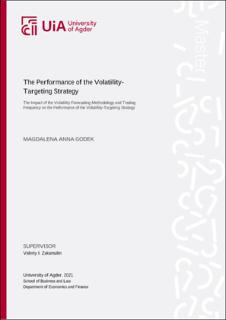The Performance of the Volatility-Targeting Strategy : The Impact of the Volatility Forecasting Methodology and Trading Frequency on the Performance of the Volatility-Targeting Strategy
| dc.contributor.author | Godek, Magdalena Anna | |
| dc.date.accessioned | 2021-09-28T09:45:26Z | |
| dc.date.available | 2021-09-28T09:45:26Z | |
| dc.date.issued | 2021 | |
| dc.identifier.citation | Godek, M.A. (2021) The Performance of the Volatility-Targeting Strategy : The Impact of the Volatility Forecasting Methodology and Trading Frequency on the Performance of the Volatility-Targeting Strategy (Master's thesis). University of Agder, Kristiansand. | en_US |
| dc.identifier.uri | https://hdl.handle.net/11250/2784047 | |
| dc.description | Master's thesis in Business administration (BE501) | en_US |
| dc.description.abstract | Many researchers analyzed the performance of the volatility-targeting strategy (see, e.g., Moreira and Muir (2017) or Harvey, Hoyle, Korgaonkar, Rattray, Sargaison, and Hemert (2018)). It is a very tempting strategy as it reduces exposure to risk, especially during crises. Typically, it works pretty well on equities and gives higher Sharpe ratios and lower drawdowns. However, the latest studies (see, e.g., Zakamulin (2019), Liu, Tang, and Zhou (2019), Cederburg, O’Doherty, Wang, and Yan (2020), or Bongaerts, Kang, and van Dijk (2020)) showed some challenges in using the strategy by practitioners. This study aims to answer the questions: does the volatility-targeting strategy outperform the buy-and-hold strategy, what volatility forecasting method to use, how often to rebalance, and does it work for other asset classes? Based on the findings from the conducted study, the main conclusion is that the volatility-targeting strategy does not consistently beat the buy-and-hold strategy. The strategy works well for equities in volatile periods in history, but it may be challenging to implement with success ex-ante. The findings are mixed for bonds. However, the active strategy does not work for commodities and currencies. Key words: volatility-targeting portfolios, risk managing JEL classification: G11, G17 | en_US |
| dc.language.iso | eng | en_US |
| dc.publisher | University of Agder | en_US |
| dc.rights | Attribution-NonCommercial-NoDerivatives 4.0 Internasjonal | * |
| dc.rights.uri | http://creativecommons.org/licenses/by-nc-nd/4.0/deed.no | * |
| dc.subject | BE501 | en_US |
| dc.title | The Performance of the Volatility-Targeting Strategy : The Impact of the Volatility Forecasting Methodology and Trading Frequency on the Performance of the Volatility-Targeting Strategy | en_US |
| dc.type | Master thesis | en_US |
| dc.rights.holder | © 2021 Magdalena Anna Godek | en_US |
| dc.subject.nsi | VDP::Samfunnsvitenskap: 200::Økonomi: 210 | en_US |
| dc.source.pagenumber | 85 | en_US |

